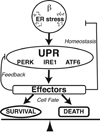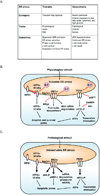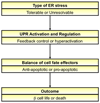The binary switch that controls the life and death decisions of ER stressed β cells
- PMID: 21168319
- PMCID: PMC3078183
- DOI: 10.1016/j.ceb.2010.11.005
The binary switch that controls the life and death decisions of ER stressed β cells
Abstract
Diabetes mellitus is a group of common metabolic disorders defined by hyperglycemia. One of the most important factors contributing to hyperglycemia is dysfunction and death of β cells. Increasing experimental, clinical, and genetic evidence indicates that endoplasmic reticulum (ER) stress plays an important role in β cell dysfunction and death during the progression of type 1 and type 2 diabetes as well as genetic forms of diabetes such as Wolfram syndrome. The mechanisms of ER stress-mediated β cell dysfunction and death are complex and not homogenous. Here we review the recent key findings on the role of ER stress and the unfolded protein response (UPR) in β cells and the mechanisms of ER stress-mediated β cell dysfunction and death. Complete understanding of these mechanisms will lead to novel therapeutic modalities for diabetes.
Copyright © 2010 Elsevier Ltd. All rights reserved.
Figures



There are two types of ER stress conditions: tolerable and unresolvable. Tolerable ER stress can be physiological, acute, and/or mild. Under tolerable ER stress conditions, the UPR is properly activated and regulated reducing ER stress and promoting β cell adaptation and survival. In contrast, unresolvable ER stress conditions are pathological, chronic, and/or severe. Under unresolvable ER stress conditions, the UPR is hyperactivated inducing β cell dysfunction and death.
When β cells are exposed to physiological stimuli that induces tolerable ER stress, the UPR triggers transcription of adaptive and survival genes, attenuates translation, and promotes mild mRNA degradation to reduce ER stress. The UPR also promotes proinsulin biosynthesis. As ER homeostasis is restablished, BiP, Gadd34, P58IPK, RACK1 and WFS1 properly turn off different components of the UPR.
When β cells are under pathological conditions that induce unresolvable ER stress, the UPR is hyperactivated triggering the activation of apoptotic pathways and upregulating apoptotic genes. The UPR also mediates degradation of mRNAs encoding proinsulin and ER homeostatic proteins. Under these conditions, the UPR bypasses feedback regulation.

References
-
- Donath MY, Halban PA. Decreased beta-cell mass in diabetes: significance, mechanisms and therapeutic implications. Diabetologia. 2004;47:581–589. - PubMed
-
-
Butler AE, Janson J, Bonner-Weir S, Ritzel R, Rizza RA, Butler PC. Beta-cell deficit and increased beta-cell apoptosis in humans with type 2 diabetes. Diabetes. 2003;52:102–110. References and propose that β cell death is a critical pathogenic component in both type 1 and type 2 diabetes.
-
-
-
Oslowski CM, Urano F. The binary switch between life and death of endoplasmic reticulum-stressed beta cells. Curr Opin Endocrinol Diabetes Obes. 2010 This is the first article proposing that the UPR acts as a bianary switch regulating life and death of ER stressed β cells.
-
-
- Eizirik DL, Cardozo AK, Cnop M. The role for endoplasmic reticulum stress in diabetes mellitus. Endocr Rev. 2008;29:42–61. - PubMed
-
-
Fonseca SG, Ishigaki S, Oslowski CM, Lu S, Lipson KL, Ghosh R, Hayashi E, Ishihara H, Oka Y, Permutt MA, et al. Wolfram syndrome 1 gene negatively regulates ER stress signaling in rodent and human cells. J Clin Invest. 2010 This article reports that β cell death in Wolfram syndrome is caused by the hyperactivation of ER stress signaling.
-
Publication types
MeSH terms
Grants and funding
LinkOut - more resources
Full Text Sources
Other Literature Sources

